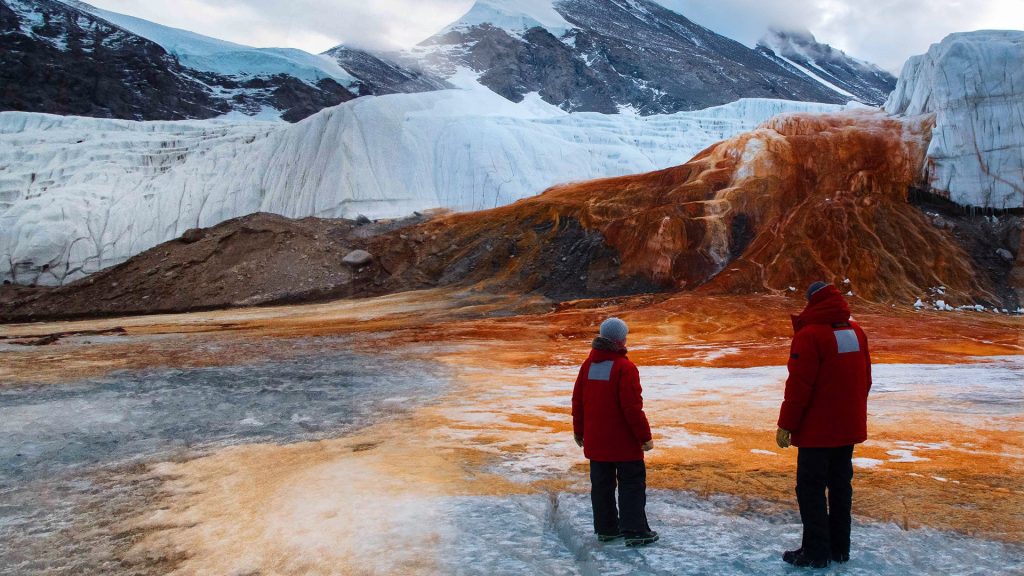| Creator | Ariel Waldman |
| Media Form | Documentary Photography |
| Genre | Nature |
| Technique | Photography |
| Date and Location of Creation | February 12, 2020 |
| Publication Information | PBS Documentary “Why is this Antarctic Glacier “Bleeding?”” |
| Natural Phenomenon Represented | “Blood Falls” in Antarctica |
There’s blood in the water in Antarctica, except it’s not really blood. For the most part.
Antarctica’s icy desolation harbors a natural phenomenon known as Blood Falls, where the Taylor Glacier weeps scarlet tears. Its existence has intrigued scientists and adventurers alike for decades, defying any conventional explanation.
Blood Falls’ beguiling nature not only exists with its visually striking experience, the red amongst the pristine snow but also in its untold stories.
The Photography of Blood

A photographer’s camera is its tool in exposing concealed narratives, some which exist within Blood Falls and its many layers of geological history and scientific inquiry.
“In a culture saturated by disinformation and cover-ups and restricted by repression and censorship, photography became an essential tool to bring the truth to light,” writes Ángeles Donoso Macaya in The Insubordination of Photography: Documentary Practices Under Chile’s Dictatorship. This sentiment seamlessly intertwines with our exploration of Blood Falls in the sense that the camera, like the red streams within Antarctica’s icy landscape serves as a beacon for the uncovering of the narratives that lie within the natural world and the fabric of our human society. Just as photography played a crucial role in bringing the truth to light during a dark period of oppression, it continues to depict our environmental neglect and degradation.
According to Harry Ransom Center, the first surviving utilization of a photograph, or creation of a photograph, was by Joseph Nicéphore Niépce, in the process which he then referred to as héliographie or “sun writing”.
Photography, specifically in a documentative format, allows people to gain access to what we need to know, whether it be horrific or not. As witnesses to Blood Falls, we see that below the surface there is a narrative revolving around our environment, more so how we’re impacting it. It then becomes more of a silent plea for us to confront the consequences of our actions.
In turn, phenomena, such as Blood Falls, become canvases in which we project our fascination with the unknown. They are truly a testament to what we believe to be enduring in nature, but also how we connect to it with our human curiosity. When the water’s red becomes a metaphor for the bleeding wounds inflicted upon our environment, we must consider it a call to action that resonates with photography’s truly transformative powers.
The Nature of Blood
Peeling back the layers of mystery that shroud Blood Falls, a scientific explanation is unveiled, tightly concealed beneath the earth’s geological processes and elemental compositions.
As described by National Geographic, having originally attributed to red algae, the color of “Blood Falls” has recently been discovered to be a result of high counts of iron and salt, that work harmoniously within Antarctica’s frigid climate. Flowing from Taylor Glacier to West Lake Bonney in Victoria Land, East Antarctica, the interactions between both the iron and the oxygen-rich atmosphere produce iron oxide, or rust, which paints the ice that blood-like tint.
According to the Department of Geography at the University of Cambridge, both Geology and Glaciology are currently being studied with the goal of understanding how the Earth’s surface may change over time in respect to climate change.
Understanding those aforementioned geologic and chemical processes at play deepens the appreciation for Blood Falls as a phenomenon beyond aesthetic reasons and as an element of Earth’s mysterious ecosystem. Although Blood Falls exists as a unique feature of the Earth, it also offers implications for comprehending extreme environments elsewhere in the universe as well.
The Space of Blood

Although it exists on Earth, it uniquely offers implications for the study of the universe. After all, similar harsh environments allow scientists to further their knowledge in terms of livability. This is especially useful in the context of determining the range of life existing on other planets and ecosystems such as Mars, or the similarly covered in ice Jupiter.
Mars, referred to as the “Red Planet” by the National Aeronautics and Space Administration, shares a commonality not only in the red hues of Blood Falls, but also in their similar cold, arid conditions. As a result, scientists have considered its parallels in their never-ending search for signs of life outside of Earth’s ecosystem. Blood Falls’ microbial resilience has become a crucial reference point in the prospect of said life on Mars.
Similarly, Jupiter’s moon Europa, as explained by the National Aeronautics and Space Administration, is also cloaked in a similar frozen landscape. The subglacial lakes of Antarctica prompt an interesting exploration in regards to potential subsurface bodies of water on Europa.
In relation to bodies of water, Blood Falls’ concept of flowing blood also further represents interesting themes.
The Myth of Blood

A feature unlike any other is the red water’s contrast with the white snow, and how reminiscent it is to an open wound.
In Greek Mythology, as described by Greek Legends and Myths, there is a river called the Phlegethon, which although not necessarily made of blood, is described as being made of fire. After all, it is derived from the Greek word “to burn” which is “phlegein”. Similar to the common spiritual connotation of “Hell”. In its mythological context, it’s described as a tortuous place, where people are punished in the afterlife. It was made as a place of punishment for those who committed horrendous acts.
Delving into the mystical waters of Greek mythology, the parallels between Blood Falls and the Phlegethon River are both apparent and intriguing. The vivid crimson of Blood Falls, reminiscent of flowing blood, is truly a mythological counterpart of the Phlegethon and its respective fiery currents. While Blood Falls depicts a geological process, there is an interplay between the geological wonders presented by our world, and what we’ve previously encountered in the worlds of ancient mythology. In both cases, water serves as a symbolic embodiment of the consequences of actions, with Blood Falls serving as a tangible reminder of environmental impact, while the Phlegethon is simply the concept of justice and retribution. In reality, these parallels spark dialogue in relation to how cultural storytelling has aligned with real scientific exploration and even scientific faults.
The convergence of both the above narratives, no matter their fiction, creates intricacy between symbolism and the actual physical realities of the world we live them, no matter how difficult they may be to bear.
The Humanity of Blood
A feature of the image that particularly stood out was the two people standing in front as marveled witnesses to the phenomena. Although the red that corrodes the water of Blood Falls isn’t the same shade that runs through our veins, that doesn’t mean there isn’t spilled blood in Antarctica. In fact, as described by the Australian Antarctic program, one of the biggest threats to Antarctica is human impact. For human economic benefit, species have drifted towards extinction. Therefore, the blood is on our hands, where the very ecosystem we exploit becomes the silent witnesses to our unethical, unsustainable practices, we so deeply desire to ignore.
Perhaps it’s no wonder that nature itself is the punisher of indecent human acts.
Blood Falls, Antarctica © 2023 by Alondra Nieves-Orama is licensed under CC BY-NC 4.0




